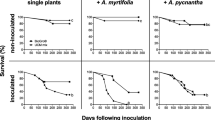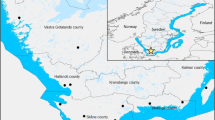Abstract
Habitat suitability for P. cinnamomi was compared between soils from the major soil groups of the Fitzgerald River National Park. Because of the mainly disease-free status of the National Park, only ex-situ testing was possible by Gradsect sampling of soils on a topographic gradient and determining the influence on disease expression in a shadehouse environment and stimulation of sporangium production in a controlled environment. The upper asymptote (Kmax), lag time (t½K) and intrinsic rate of increase (r) of the logistic model were calculated from disease progress curves of Banksia baxteri plants following soil inoculation with P. cinnamomi and sporulation curves. The Qualinup Sands and the Dry Phase of the Nyerilup Sand had the greatest % mortality Kmax values and the Perkins and Red Loams had the least. For B. baxteri mortality, delay significantly increased and rate decreased along a fertility gradient from relatively infertile sands to fertile loams. Kmax of total number of sporangia/mm2 of mycelium for winter collected soils was significantly linearly positively correlated with Kmax of germinating spores/disc and negatively correlated with rate of mortality of B. baxteri. The loams with the slowest rate of mortality of B. baxteri stimulated the most sporulation. Habitat suitability of the major soil groups of the landscape matrix of the Fitzgerald River National Park for P. cinnamomi can be used to predict risk of invasion and hazard in healthy areas and prioritise areas of greatest risk of invasion and conservation consequences from hazard.






Similar content being viewed by others
References
Bannerman S (1997) Spatial patterns and landscape ecology: implications for biodiversity. Part 3 of 7. Extension Note 14. B.C. Ministry of Forests, Victoria
Barker PCJ, Wardlaw TJ (1995) Susceptibility of selected Tasmanian rare plants to Phytophthora cinnamomi. Aust J Bot 43:379–386
Benson DM (1984) Influence of pine bark, matric potential and pH on sporangium production by Phytophthora cinnamomi. Phytopathology 74:1359–1363
Broadbent P, Baker KF (1974) Behaviour of Phytophthora cinnamomi in soils suppressive and conducive to root rot. Aust J Agr Res 25:121–137
Butcher TB, Stukely MJC, Chester GW (1984) Genetic variation in resistance of Pinus radiata to Phytophthora cinnamomi. For Ecol Manage 8:197–220
Byrt PN, Irving HR, Grant BR (1982) The effect of cations on zoospores of the fungus Phytophthora cinnamomi. J Gen Microbiol 128:1189–1198
Chabrerie O, Roulier F, Hoeblich H, Sebert-Cuvillier E, Closset-Kopp D, Leblanc I, Jaminon J, Decocq G (2007) Defining patch mosaic functional types to predict invasion patterns in a forest landscape. Ecol Appl 17:464–481
Chapman A, Newbey KR (1995) A biological survey of the Fitzgerald area, Western Australia. CALMScience 1(Supplement 3):1–258
Chee KH, Newhook FJ (1966) Relationship of micro-organisms to sporulation of Phytophthora cinnamomi Rands. New Zeal J Agr Res 9:32–43
Chen D, Zentmyer GA (1970) Production of sporangia by Phytophthora cinnamomi in axenic culture. Mycologia 62:397–402
Duniway JM (1983) Role of physical factors in the development of Phytophthora diseases. In: Erwin DC, Bartnicki-Garcia S, Tsao PH (eds) Phytophthora. Its biology, taxonomy, ecology and pathology. The American Phytopathological Society, USA, pp 175–187
Erwin DC, Bartnicki-Garcia S, Tsao PH (1983) Phytophthora. Its biology, taxonomy, ecology and pathology. The American Phytopathological Society, USA
Gillison AN, Brewer KRW (1985) The use of gradient directed transects or Gradsects in natural resource surveys. J Environ Manage 20:103–127
Gisi U, Zentmyer GA, Klure LJ (1980) Production of sporangia by Phytophthora cinnamomi and P. palmivora in soils of different matric potential. Phytopathology 70:301–306
Grant M, Barrett S (2003) The distribution and impact of Phytophthora cinnamomi Rands in the south coast region of Western Australia. In: McComb JA, StJ Hardy GE, Tommerup IC (eds) ‘Phytophthora in forests and natural ecosystems’. 2nd International IUFRO Working Party 7.02.09 Meeting, Albany, W. Australia. Murdoch University Print, Murdoch, pp 34–40
Halsall DM (1982) A forest soil suppressive to Phytophthora cinnamomi and conducive to Phytophthora cryptogea. I Survival, germination and infectivity of mycelium and chlamydospores. Aust J Bot 30:11–25
Halsall DM, Forrester RI, Moss TE (1983) Effects of nitrogen, phosphorus and calcium nutrition on growth of eucalypt seedlings and on the expression of disease associated with Phytophthora cinnamomi infection. Aust J Bot 31:341–355
Holdenrieder O, Pautasso M, Weisberg PJ, Lonsdale D (2004) Tree diseases and landscape processes: the challenge of landscape pathology. Trends Ecol Evol 19:446–452
Kelly M, Meentemeyer RK (2002) Landscape dynamics of the spread of sudden oak death. Photogramm Eng Remote Sens 68:1001–1009
Kern S, Jasper R, True D (2008) Floristic survey of the Ravensthorpe Range 2007. Report WB483 to the Department of Conservation and Environment. Western Botanical, Bassendean
Kirby KN (1993) Advanced data analysis with SYSTAT. Van Nostrad Reinhold, New York
Malajczuk N (1979) Biological suppression of Phytophthora cinnamomi in eucalypts and avocados in Australia. In: Schippers B, Gams W (eds) Soil-borne plant pathogens. Academic, London, pp 635–652
Malajczuk N (1983) Microbial antagonism to Phytophthora. In: Erwin DC, Bartnicki-Garcia S, Tsao PH (eds) Phytophthora. Its biology, taxonomy, ecology and pathology. The American Phytopathological Society, USA, pp 197–218
Malajczuk N, Sanfelieu CL, Hossen S (1983) Production and survival of Phytophthora cinnamomi zoospores in suppressive and conducive soils. Trans Br Mycol Soc 80:305–312
Marks GC, Smith IW (1981) Factors influencing suppression of root rot of Eucalyptus sieberi and E. obliqua caused by Phytophthora cinnamomi. Aust J Bot 29:483–495
Marks GC, Smith IW (1985) Rate of disease development in Eucalyptus sieberi growing in suppressive soils inoculated with Phytophthora cinnamomi. Aust J Bot 33:159–165
Marks GC, Kassaby FY, Fagg PC (1973) Dieback tolerance in Eucalypt species in relation to fertilization and soil populations of Phytophthora cinnamomi. Aust J Bot 21:53–65
Moran MD (2003) Arguments for rejecting the sequential Bonferroni in ecological studies. Oikos 100:403–405
Moreira AC, Martins JMS (2005) Influence of site factors on the impact of Phytophthora cinnamomi in cork oak stands in Portugal. For Pathol 35:145–162
Myers N (2001) Mediterranean-climate regions: glowing hotspots of diversity. J Mediterr Ecol 2:157–163
Nesbitt HJ, Malajczuk N, Glenn AR (1979) Effect of organic matter on the survival of Phytophthora cinnamomi Rands in soil. Soil Biol Biochem 11:133–136
Newbey KR (1979) The vegetation of central south coastal Western Australia. M. Phill thesis, Murdoch University, Western Australia
Ostfeld RS, Glass GE, Keesing F (2005) Spatial epidemiology: an emerging (or re-emerging) discipline. Trends Ecol Evol 20:328–336
Otrosina WJ, Marx DH (1975) Populations of Phytophthora cinnamomi and Pythium spp. under shortleaf and loblolly pines in littleleaf disease sites. Phytopathology 65:1224–1229
Plantegenest M, Le May C, Fabre F (2007) Landscape epidemiology of plant diseases. J R Soc Interface 4:963–972
Podger FD (1972) Phytophthora cinnamomi, a cause of lethal disease in indigenous plant communities in Western Australia. Phytopathology 62:972–981
Podger FD (1989) Comparative pathogenicity of fourteen Australian isolates of Phytophthora cinnamomi determined on transplants of Tasmanian temperate heathland. Aust J Bot 37:491–500
Schmitthenner AF, Canaday CH (1983) Role of chemical factors in development of Phytophthora diseases. In: Erwin DC, Bartnicki-Garcia S, Tsao PH (eds) Phytophthora. Its biology, taxonomy, ecology and pathology. The American Phytopathological Society, USA, pp 189–196
Shea SR, Gillen KJ, Leppard WI (1980) Seasonal variation in population levels of Phytophthora cinnamomi Rands in soil in diseased, freely drained Eucalyptus marginata Sm sites in the northern jarrah forest of south-western Australia. Protection Ecology 2:135–156
Shearer BL, Crane CE (2009) Influence of site and rate of low-volume aerial phosphite spray on lesion development of Phytophthora cinnamomi and phosphite persistence in Lambertia inermis var. inermis and Banksia grandis. Australas Plant Pathol 38:288–304
Shearer BL, Dillon M (1995) Susceptibility of plant species in Eucalyptus marginata forest to infection by Phytophthora cinnamomi. Aust J Bot 43:113–134
Shearer BL, Dillon M (1996a) Impact and disease centre characteristics of Phytophthora cinnamomi infestations of Banksia woodlands on the Swan Coastal Plain, Western Australia. Aust J Bot 44:79–90
Shearer BL, Dillon M (1996b) Susceptibility of plant species in Banksia woodlands on the Swan Coastal Plain, Western Australia, to infection by Phytophthora cinnamomi. Aust J Bot 44:433–445
Shearer BL, Smith IW (2000) Disease of eucalypts caused by soilborne species of Phytophthora and Pythium. In: Keane PJ, Kile GA, Podger FD, Brown BN (eds) Diseases and pathogens of eucalypts. CSIRO, Australia, pp 259–291
Shearer BL, Tippett JT (1989) Jarrah dieback: the dynamics and management of Phytophthora cinnamomi in the jarrah (Eucalyptus marginata ) forest of south western Australia. Research Bulletin 3. Department of Conservation and Land Management, Perth
Shearer BL, Crane CE, Cochrane A (2004) Quantification of the susceptibility of the native flora of the South-West Botanical Province, Western Australia, to Phytophthora cinnamomi. Aust J Bot 52:435–443
Shearer BL, Crane CE, Barrett S, Cochrane A (2007a) Phytophthora cinnamomi invasion, a major threatening process to conservation of flora diversity in the South-west Botanical Province of Western Australia. Aust J Bot 55:225–238
Shearer BL, Crane CE, Barrett S, Cochrane A (2007b) Assessment of threatened flora susceptibility to Phytophthora cinnamomi by analysis of disease progress curves in shadehouse and natural environments. Australas Plant Pathol 36:609–620
Shearer BL, Crane CE, Fairman RG, Dunne CP (2009) Ecosystem dynamics altered by pathogen-mediated changes following invasion of Banksia woodland and Eucalyptus marginata forest biomes of south-western Australia by Phytophthora cinnamomi. Australas Plant Pathol 38:417–436
Shearer BL, Crane CE, Cochrane JA (2010) Variation in susceptibility to Phytophthora cinnamomi infection within the genus Lambertia. Aust J Bot 58:575–585
Sochacki SJ (1982) A comparative study of four northern jarrah forest soil types in relation to Phytophthora cinnamomi Rands. Honours Thesis, Murdoch University, Western Australia
Stukely MJC, Crane CE (1994) Genetically based resistance of Eucalyptus marginata to Phytophthora cinnamomi. Phytopathology 84:650–656
Weste G, Ruppin P (1977) Phytophthora cinnamomi: population densities in forest soils. Aust J Bot 25:461–475
Weste G, Vithanage K (1979) Production of sporangia by Phytophthora cinnamomi in forest soils. Aust J Bot 27:693–701
Wilson BA, Aberton J, Cahill DM (2000) Relationships between site factors and distribution of Phytophthora cinnamomi in eastern Otway Ranges, Victoria. Aust J Bot 48:247–260
With KA (2004) Assessing the risk of invasive spread in fragmented landscapes. Risk Anal 24:803–815
Acknowledgements
We thank J Kinal for help in soil sampling, S. McArthur and L. Wong for soil analysis and S. Barrett, C. Dunne, J. McComb and M. Shearer for checking the manuscript.
Author information
Authors and Affiliations
Corresponding author
Rights and permissions
About this article
Cite this article
Shearer, B.L., Crane, C.E. Habitat suitability of soils from a topographic gradient across the Fitzgerald River National Park for invasion by Phytophthora cinnamomi . Australasian Plant Pathol. 40, 168–179 (2011). https://doi.org/10.1007/s13313-010-0026-6
Received:
Accepted:
Published:
Issue Date:
DOI: https://doi.org/10.1007/s13313-010-0026-6




